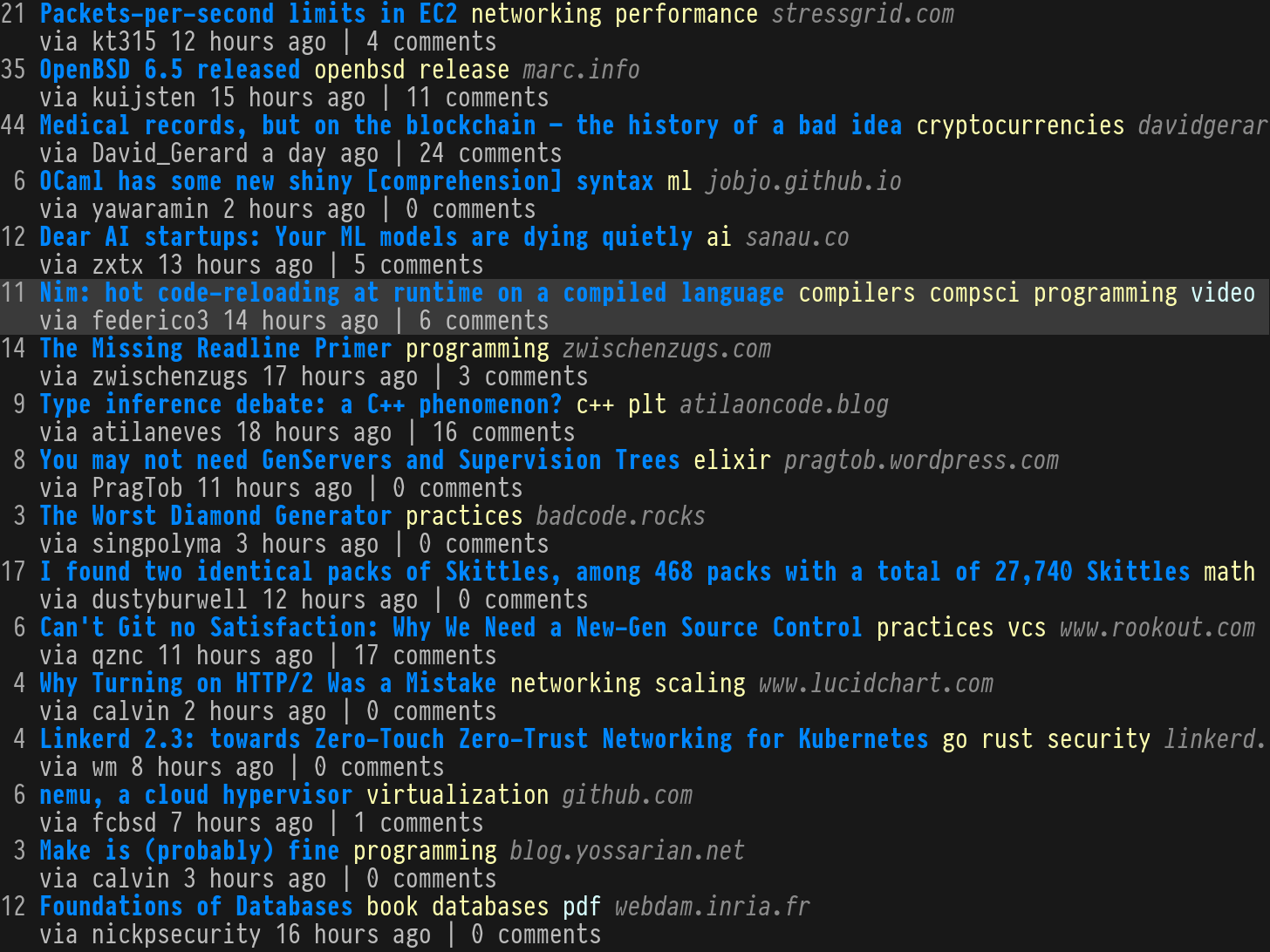Published on
As a learning and practice exercise I built acratefor interacting with theLobstersprogramming community website. It’s built on the asynchronous Rust ecosystem. To demonstrate the crate I also built a terminal user interface (TUI).

Try It
Pre-built binaries with no runtime dependencies are available for:
- FreeBSD (AMD)
- Linux armv6 (Raspberry Pi)
- Linux x 86 _ 64
- MacOS
- NetBSD 8 amd 64
- OpenBSD 6.5 amd 64
The TUI uses the following key bindings:
jor↓– Move cursor downkor↑– Move cursor uphor→– Scroll view leftlor→– Scroll view rightEnter– Open story URL in browserc– Open story comments in browserqorEsc– Quit
As mentioned in the introduction the motivation for starting the client was to practice using the async Rust ecosystem and it kind of spiralled from there. The resulting TUI is functional but not especially useful, since it just opens links in your browser. I can imagine it being slightly more useful if you could also view and reply to comments without leaving the UI.
Building It
The client proved to be an interesting challenge, mostly because Lobsters doesn’t have a full API. This meant I had to learn how to set up and use a cookie jar along sidereqwestin order to make authenticated requests. Logging in requires supplying a cross-site request forgery token, which Rails uses to prevent CSRF attacks. To handle this I need to first fetch the login page, note the token, then POST to the login endpoint. I could have tried to extract the token from the markup with a regex or substring matching but instead usedkuchikito parse the HTML and then match on themetaelement in thehead.
Once I added support for writing with the client (posting comments), not just reading, I thought I best not test against the real site. Fortunately the site’s code is open source. I took this as an opportunity to usemy new-found Docker knowledgeand run it with Docker Compose. That turned out pretty easy since I was able to base it on one of the Dockerfiles for a Rails app I run. If you’re curious theAlpine Linux (based) Dockerfileanddocker-compose.ymlcan be viewed inthis paste.
After I had the basics of the client worked out I thought it would be neat to fetch the front page stories and render them in the terminal in a style similar to the site itself. I initially did this withansi_term. It looked good but lacked interactivity so I looked into ways to build a TUI along the lines oftig. I built it several times with different crates, switching each time I hit a limitation. I tried:
- Easycurses, which lived up to it’s name and produced a working result quickly. I’d recommend this if your needs aren’t too fancy, however I needed more control than it provided.
- Pancursesdidn’t seem to be able to use colors outside the core 16 from ncurses.
Finally I ended up going a bit lower-level and usedtermion. It does everything itself but at the same time you lose the conveniences ncurses provides. It also doesn’t support Windows, so my plans of supporting that were thwarted. Some time after I had thetermionversion working I revisitedTUI-RS, which I had initially dismissed as unsuitable for my task. In hindsight it would probably have been perfect, but we’re here now.
In addition to async and TUI I also learned more about:
- Building a robust and hopefully user friendly command line tool.
- Documenting a library.
- Publishing crates.
- Dockerising a Rails app that uses MySQL.
- How to build and publish pre-built binaries for many platforms.
- How to accept a password in the terminal without echoing it.
- Setting up multi-platformCI builds on Sourcehut.
Whilst the library and UI aren’t especially useful the exercise was worth it. I got to practice a bunch of things and learn some new ones at the same time.
Previous Post:Cross Compiling Rust for FreeBSD With Docker
Next Post:An Illustrated Guide to Useful Command Line Tools







GIPHY App Key not set. Please check settings